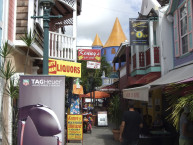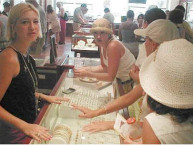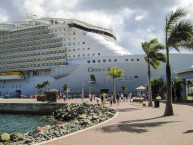Opal
Opals are one of the more interesting gemstones available in the Caribbean. Opals are formed as the result of silicon rich water seeping down through the ground into cavities most often formed by the decay of fallen trees. As the water evaporates, it leaves the silicon to solidify into a hardened mass known as an opal.
As a result of this formation opals will generally be 10 percent to 15 percent water. It is this presence of water that causes an opal to have the wonderful rainbow of colors. The colors are generated as light travels through the water in the stone and is refracted into its spectral colors.
Opals should be well cut and offer very nice change of colors as it is rotated in the light. Milk opal will be the variety that is mostly white and is inexpensive. Opals with red and blue colors will be some of the most prized. And fire opal is a semi-transparent variety that is orange in color.
One should be aware that the majority of jewelry with opal inlays are actually using lab-created stones and not natural opal. If the stones seem too perfectly matched, are of an unusually color or appear to have a striped pattern they may be lab-created. Be sure to ask the sales person if they are natural.
Factors that influence Market Value of Opals:
Type of Opal: Opal comes in many different types. Some depend on the source of Opal, but others are found in more than one location. Common types are solid opal, boulder opal, matrix opal, assembled opal (doublets and triplets) treated or dyed opal, man-made opal, and opal simulants. In addition, type may include the location where the opal is found such as Mexican Opal. The type of opal has a major effect on market value. As a rule solid opals are more highly valued than Matrix opals, with doublets and triplets even farther down the line. Synthetics have become more expensive and often cost more per carat than some solid natural opals. Imitations are usually inexpensive.
Brightness of Fire: The brightness of the fire coming from the stone. To be assessed independently of any other factor.
Base Color: The background color of the stone. This background color may be part of the precious opal, a patch behind the color, or another kind of stone. Background colors include black, semi-black, crystal, semi-crystal, white, orange, gray, brown, boulder black and boulder brown.
Fire Color: The color or combination of colors which are produced when light is diffracted out from the stone. Red, orange, green, and blue are the most common fire colors found in pure form or in combination.
Fire Pattern: The pattern made by the play of color. Patterns are infinite and no two are identical, but they can generally be categorized into pinfire, flashfire, broad flashfire, rare patterns, and harlequins.
Rarity: Some stones are rare or unusual and need to be given special attention. Rarity comes from a unique combination of characteristics. For example, some stones have pictures in them which are particularly attractive. They are named for the picture.
Cut: The overall shape and quality of cutting. This includes shape, dome, inclusions, and fractures.
Consistency of Fire: The ideal stone that shows good fire in all directions as you turn it or pick it up. A stone which shows color only in one direction is call “highly directional”. Such a stone would have a lower market value. The is, of course, a continuum from non-directional to highly directional.
Types of Opal:
Black Opal: A solid opal which is opaque when viewed from the top of the stone and which has a play of color against a dark background graded as at least number 3 black on the Lightning Ridge Miners Association Tone Scale. GIA defines black opal as translucent to opaque with a play of color against a black, dark gray, blue, green, brown or other dark body color. Lightning Ride is a bit stricter in their criteria for true black. Lack of understanding and experience among gemologists has lead to problems in defining true black opals. The most valuable of base colors for opals is black and so carries a premium price.
In order for a stone to be truly black, it must have a rich dark black background. This would be simple if all opals either had this dark base color or a light one. But nature doesn’t work this way. Base colors come in all shades of gray. The top of the line black opal is one that shows a liquid royal blue that flows over the top of a stone with other colors on a dense black background. The price jumps dramatically if it also contains vibrant fire such as red or green. This is the BEST gem black opal.
Semi-Black Opal: A solid opal which is translucent to opaque when viewed from the top and which has a play of color against a dark background.
Crystal Opal: A solid opal which is transparent , showing a play of color and no base color.
Jelly Opal: A solid Opal which is transparent, showing no play of color, but it may show an opalescence without a pattern in the fire. The orange material without a play of color from Mexico is frequently seen in faceted stones, and would be properly termed orange jelly.
Mexican fire opal is the most famous type from Mexico’s volcanic deposits around Queretaro. Named for its bright reddish-orange color instead of any play-of-color, fire opal is the only opal that is typically faceted. Usually Mexican opal in other colors are domed and sold as oval or round cabochons for jewelry use. Artifacts show that Mexican opal was used at least as far back as the Aztecs. Less expensive than many other jewels, Mexican fire opal is also one of the few genuine orange gemstones.
Boulder Opal: The best boulder opal may rival black opals in beauty and has rapidly been gaining in popularity. In value it is second only to black opal. Boulder opals are strong, unique and offer a range of patterns. Boulder opal is a natural combination of precious opal and ironstone or other parent rock. Many people collect specimens of boulder opal to place on shelves, and many designers are incorporating boulder opals into their designs for that “one of a kind” look.
White or Milky Opal: The most common of all opal available to consumers. It has a light or pale background and often displays red, green and blue pinfire. Prices are generally more affordable for this type of opal, due to its abundance.
Lightning Ridge: When shopping for opals you will hear this mentioned often. This is an area of New South Wales which is world famous for its black opal.
Gilson Opal: A synthetic (man-made) opal originated by Pierre Gilson.
Solid Opal: Solid Opals are one piece of solid Opal which are cut with a smooth rounded surface (Cabochon cut) rather than a faceted surface. Solid Opals are generally more valuable and expensive than doublet and triplet Opals as they contain a higher carat weight of Opal.
Doublet Opals: A two part stone consisting of a precious opal glued to another stone, either opal or some other material. Doublet Opals are Opals which when found are not thick enough to be cut as solid Opals. Good doublet Opals are very colorful and appealing and are a great alternative for people looking for an attractive piece of Opal Jewelry without spending the price demanded by solid Opals.
Triplet Opals: A three part stone with a precious opal center, a clear cap, and a darkened base. As triplet Opals consist of the least carat weight of Opal they are generally priced significantly lower than solid and doublet Opals.
Inlay Opal: Inlaid Opals are solid Opals which have been inserted into a piece of Jewelry so that the Jewelry’s metal surface is level with the surface of the Opal. You will see this with many designer lines.
Care of Opals: Opals are fairly soft so they should not be roughly worn and should be oiled occasionally to seal the stone from losing its internal water. Do not use a home ultrasonic machine or jewelry cleaner. Care should be taken to protect it from scratches, sharp blows, household chemicals, and extreme temperature changes. To maintain the brilliance of opal, it should be wiped clean with a soft cloth.
Legends of Opal:
Opal has symbolized hope, innocence and purity through the ages. In the Middle Ages, young, fair-haired girls wore opals in their hair to protect its lovely blond color. Medieval writers believed opal could render its wearer invisible when the need arose.
In ancient Rome, Senator Nonius had a beautiful opal ring, so beautiful and precious that Marc Anthony demanded that Nonius turn it over to him. Rather than give it up, the senator left the country, leaving all of his possessions except for the ring.
Sir Walter Scott wrote a novel called “Anne of Geirstein”. This novel was about an enchanted Lady Hermone. She appeared out of nowhere, and always wore an opal in her hair. This opal was almost a part of the woman – when she was happy, it sparkled with all the iridescence of an opal, but when she was angry, it flashed angry red lights at all. When some holy water was sprinkled on the stone, it lost all its beauty and the spell on Lady Hermione was broken.
During the time of Queen Elizabeth, Opal was written “ophal.” Some believe the name was derived from the word “opthalmos” meaning, “the eye” Thus in ancient times, Opal was said to be intimately connected with a belief in the Evil Eye.
Queen Victoria was extraordinarily fond of the opal, and wore it all the time to show that there was no bad omen on the stone. She gave one to each of her daughters for their wedding.
Over the years, a superstition developed which said the stone caused bad luck if gazed upon. In contrast, another folktale of a later date suggests that looking at Opal is actually good for the eyes. It was thought to banish evil spirits and favor children, the theater, amusements, friendships and feelings.
Today if you ask ten people what folklore they have heard about opals you may get ten different but interesting tales. One look at a fine opal and you will understand, just like a beautiful woman, the rumors and legends do fly!



